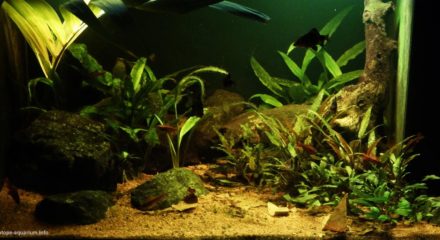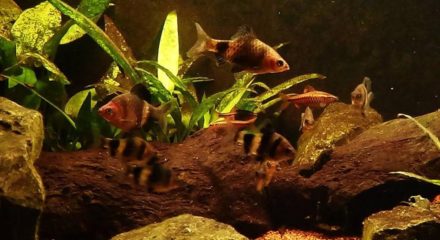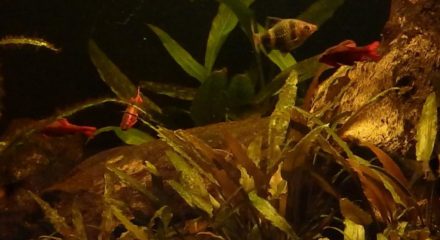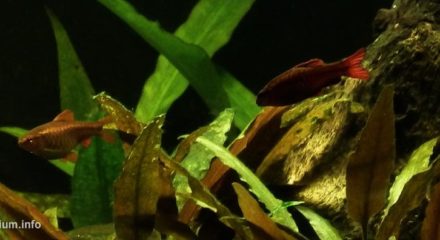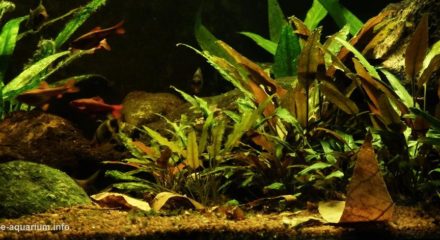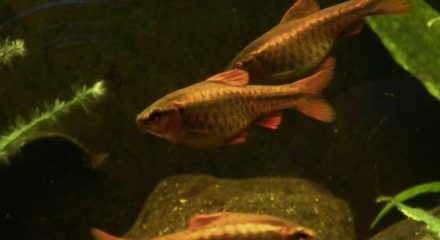Riverbank of a small stream in Nilwala basin, Sri Lanka
56th place in Biotope Aquarium Design Contest 2016
![]() Belgium. Jeroen Vanhooren
Belgium. Jeroen Vanhooren
Aquarium Volume: 100 L
Fish and invertebrates: Puntius titteya, Pethia nigrofasciata
Plants list: Lagenandra thwaitesii, Cryptocoryne beckettii
Biotope description: This aquarium simulates a riverbank of a small stream in the Nilwala basin at an elevation of about 200 m. At this elevation Pethia nigrofasciata and Puntius titteya could meet. They are endemic to the southwestern wet zone of Sri Lanka and inhabit lowland tropical rainforest streams. The wet zone receives huge amounts of rainfall because of the monsoons between March and August. These streams are shaded because of the overhanging forest canopy. Water is clear, soft and slightly acidic. There are only few macrophytes in these systems, but marginal vegetation could be dense. This is an ideal place for smaller fishes to hide from predators (such as Channa orientalis). Typical substrate is sandy with some smaller rocks and leaf litter. Other fish that can be found in these streams are Rasboroides vaterifloris, Puntius bimaculatus, P. kelumi, Pethia nigrofasciata, Dawkinsia singhala, Schistura notostigma, Mystus vittatus, Aplocheilus werneri, Channa orientalis, Malpulutta kretseri, and Mastacembelus armatus. Sadly enough Sri Lankan rainforest is under huge pressure. In 2006 only 4,6 % of the original rainforest was left, as a result of plantation activities. This is of course dramatic for these vulnerable ecosystems.
Fish and invertebrates: Puntius titteya, Pethia nigrofasciata
Plants list: Lagenandra thwaitesii, Cryptocoryne beckettii
Biotope description: This aquarium simulates a riverbank of a small stream in the Nilwala basin at an elevation of about 200 m. At this elevation Pethia nigrofasciata and Puntius titteya could meet. They are endemic to the southwestern wet zone of Sri Lanka and inhabit lowland tropical rainforest streams. The wet zone receives huge amounts of rainfall because of the monsoons between March and August. These streams are shaded because of the overhanging forest canopy. Water is clear, soft and slightly acidic. There are only few macrophytes in these systems, but marginal vegetation could be dense. This is an ideal place for smaller fishes to hide from predators (such as Channa orientalis). Typical substrate is sandy with some smaller rocks and leaf litter. Other fish that can be found in these streams are Rasboroides vaterifloris, Puntius bimaculatus, P. kelumi, Pethia nigrofasciata, Dawkinsia singhala, Schistura notostigma, Mystus vittatus, Aplocheilus werneri, Channa orientalis, Malpulutta kretseri, and Mastacembelus armatus. Sadly enough Sri Lankan rainforest is under huge pressure. In 2006 only 4,6 % of the original rainforest was left, as a result of plantation activities. This is of course dramatic for these vulnerable ecosystems.

